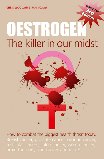Actually, not exactly. Oestrogen or estrogen, depending upon what side of the Atlantic you reside, is a family of hormones.
Estrogen Family members
More correctly one, estrone, (oestrone), is the female sex hormone. It is made via the C-2 biochemical pathway in the ovaries. It attaches to cellular receptor sites and, like any hormone, delivers its functional message. Estrone declines as women enter menopause.
Unfortunately, there is another family member, made from your fat stores – yes, women and men too - by aromatase enzymes via the C-16 pathway. It is called estradiol (oestradiol) and sits on the same cellular receptor sites that estrone uses. However, estradiol creates havoc inside the cell, throwing out sodium and potassium levels, oxygen and acidity, and powering down the cell.
A third estrogen group within this ‘family’ are phytoestrogens typically found in vegetables and fruits particularly greens and pulses. They bind much more weakly to the same receptor sites, and are more easily washed through the body, so you need to eat them every day to block your receptors from attack by more dangerous members.
“There is a great book from Chris Woollams on this whole subject – Called ‘Oestrogen, the killer in our midst’ Click here to buy”.
 There are also natural compounds that can have positive effects in regulating human estrogens – for example, flaxseed, genistein (in red clover), melatonin (the sleep hormone that regulates body estrogen), certain mushrooms and Indole 3 carbinol/DIM. Your gut bacteria and the amount of fibre you consume are also important.
There are also natural compounds that can have positive effects in regulating human estrogens – for example, flaxseed, genistein (in red clover), melatonin (the sleep hormone that regulates body estrogen), certain mushrooms and Indole 3 carbinol/DIM. Your gut bacteria and the amount of fibre you consume are also important.
Chemical oestrogen mimics
Estrogen mimics, or xenoestrogens, are a group of different molecules that, in fact, do not seem to have many similarities.
However, they possess the same ability to lock onto estrogen receptor sites on cells.
Some deliver messages of havoc into cells; whilst others may simply block the normal action of human estrogen from reaching the receptors. The later group is more correctly termed estrogen antagonists. A third group of chemicals has been shown to damage hormone production in humans. Unfortunately a large proportion of these chemicals can by-pass the normal regulation systems of the body.
Their effects have been linked to decreases in male sperm counts, early puberty and rising rates of endometriosis in women. They can lead to infertility. In the waters off California and in certain rivers, hermaphrodite fish and frogs have been found; their condition has been linked to the estrogen mimic effects of pesticides draining into the waters.
Widespread and cumulative dangers
Of course there are Government ‘safe’ limits set for any ingredient. However, in the case of these hormone mimics, research from Dr. Ana Soto at Tufts, has shown that they are cumulative in the human body. There is no safe limit.
So how can humans avoid hormone mimics and gender benders. Here’s a ‘starter’ list of
How to avoid key estrogen mimics:
- Avoid certain pesticides, herbicides, insecticides The most notorious case was that of DDT causing a 4-fold rise in breast cancer rates in Israel, over rates in Europe. This was tracked to the use of DDT and its entry into the food chain via grazing cattle. DDT and Lindane were subsequently ‘banned’ – but only from sale in the Western world. They are still made and sold to third world countries, for example in Africa and Asia, who now supply foods to Western markets!
Other commen chemcals of concern include organophosphates like carbendaZim and endosulphan. the only real answer is to go organic and even grow your own.
- Avoid certain preservatives like Parabens. Found in deodorants, toothpastes, shampoos, moisturisers and more. Often in ‘natural products’!
- Avoid plasticisers like Bisphenol A or BPA, (in plastic bottles, while can liners), and phthalates (plastic bottles). They especially occur when heat denatures the plastic and releases more chemicals into the liquids contained. Phthalates are also found in hair sprays, perfumes, nail polishes and more.
- Avoid suncreams contain oxybenzone, retinyl palmitate and PABA. And possibly phthalates from bottles left in the sun.
- Avoid skin contact with perfumed products. Perfumes rarely disclose the chemicals used. At the last count, 16 were estrogen mimics.
- Avoid the contraceptive pill and especially HRT. Who needs the added estrogen?
- Drink clean water in cities. Many cities recycle their water but don’t have the filtration systems capable of removing the chemical estrogens in the water.
- Clean up your personal care products. A UK research study showed on average a woman comes into regular contact with over 680 chemical compounds – many are estrogen mimics. For example, Toluene in some nail polishes, Xylene (Dimethyly benzene) in laquers and nail polishes, alkylphenol ethoxylates (hormone disrupters also linked to asthma) in shaving gels, hair colours.
Overall
Sadly, the list seems endless.
The only smart answer is to find a company that avoids ALL the chemicals of concern in personal care, toiletry and in-home products.
CLICK HERE for a link to a company that we think is the really SMART CHOICE in the truly toxin-free arena.